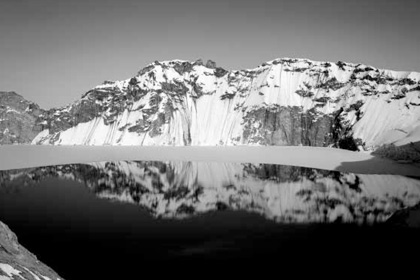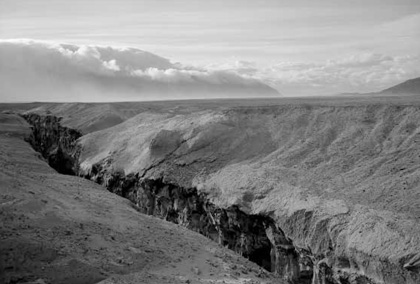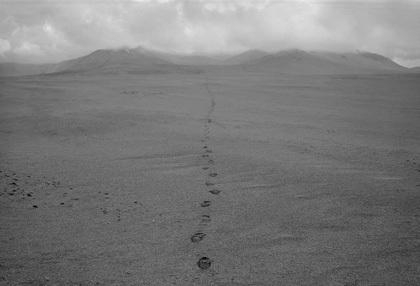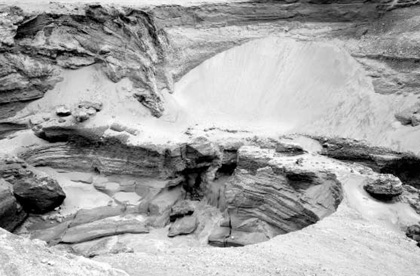
| |
| Read the most recent review ofThe Valley of 10,000 Smokes here, on the Deisgn Observer blog, written by John Foster. | |
 |
"Gary Freeburg is no casual tourist in the Valley of 10,000 Smokes. His images—every bit as sublime as his subtitle promises in their beauty and terror—were hard won over years of earned intimacy. And yet the book is more even than the images, with its superb work of contextualizing the history of the Griggs expeditions of 1916–1919 and with enlightened essays on geology by John Eichelberger and on culture by Jeanne Schaaf. As Freeburg followed in the footsteps of Griggs, we follow Freeburg from the safety of our armchairs, our eyes filled with awe and wonder." —David Stevenson, Director, M.F.A in Creative Writing and Literary Arts Department, University of Alaska Anchorage "Gary Freeburg's stunning—I mean knock-you-on-the-head stunning—photographs of the Valley of 10,000 Smokes in Alaska reveal not only its austere beauty, but its ongoing dynamism. Freeze-thaw, bear tracks, glacial turmoil, wild rivers…There's enough magic in these photographs and accompanying text to satisfy all readers." |
| "The Valley of 10,000 Smokes by Gary Freeburg, photographer, and essays by John Eichelberger and Jeannne M. Schaaf is an interesting book of reflections on our planet and the meanings and inspirations we can draw from observing changes in natural environments. Freeburg journeyed to a very remote part of Alaska surrounding Mt. Novarupta, which erupted in the fourth largest volcano every recorded and caused the collapse of Mt. Katmai in June of 1912. Soon after that eruption an expedition went to study the area and photograph it, and as a result President Woodrow Wilson made it Katmai National Park and Preserve. Freeburg and his team returned there a century later to study and photograph the same area, forever changed by the volcano, although some of the terrain still has smoking fumaroles. The black-and-white photos from a century ago and the color ones which are current make an unusual and informative collection to compare the landscapes. The essays that accompany the photographs are thought provoking and well written." —Bonnie Neely, from her four-star book review for Amazon |
 |
|
"At the height of the Vietnam War, Gary Freeburg sits in a Buddhist rock garden on military leave to Japan in 1971. He visits the garden every day, each time struck by the way the sand shifts, while the stones remain stationary. 'As I sat there, I didn't think about the war; I didn't think about what was going on around me: this garden absorbed so much of my attention.' It was at this moment that Gary realised, 'In desolation, there is beauty.' Gary carries this idea with him today, as he photographs volcanic regions in Alaska, particularly the Valley of Ten Thousand Smokes, a 44-square mile landscape of volcanic ash and pumice buried 1,000 feet deep. From the formation of this new earth surface, Gary sees balance, a site of shapes, shadows, textures: a 'giant geological garden of contemplation,' he says." |
"Greatness can exist, in and of itself, as simply the supersized extreme of whatever metric is used for quantification—great size, great weight, great wealth, great distance. To attain the level of sublime, however—that mythical, mysterious quality of greatness—takes more than just counting preponderance plus some. It's the heightened realization that only comes from appreciating what's there from what's missing. In Southwest Alaska's Valley of Ten Thousand Smokes, and Gary Freeburg's photography of it, experiencing the sublime of what is comes from the contrast of what is not." "Your publication is a marvelous tribute to you and the Griggs' expeditions of 1915-1919. ... Your photography is stunning!" |
 |
 |
"This horizontal-format book showcases the black-and-white and color landscape photographs of Gary Freeburg, following in the footsteps of National Geographic explorer Robert F. Griggs. Selections from the photographs of Griggs's 1915-19 expeditions to Alaska are shown in the first section and throughout the essay sections of the book. The whole is finely produced by George F. Thompson Publishing. Most of the book is filled with Freeburg's photographs. Each is given a full page with plenty of white space and a facing page carrying small captions. The interspersed essays are by John Eichelberger and Jeanne M. Schaaf and tell the story of the Griggs expeditions, with meditations on the volcanic landscape. Griggs's original four-year exploration of this area was the result of the second-largest volcanic eruption in modern times, comparable only to the explosion of Kratatoa. It resulted in the formation of a new volcano, which drew the interest of the public and the National Geographic Society. The icy, steaming desert Griggs and his team documented in the first decade of the twentieth century, and Freeburg documents in the first decade of the twenty-first, is called the Valley of 10,000 Smokes. The Griggs expeditions' photos are remarkable. Freeburg has the skill to equal them without matching them. His palette of silver grays is similar, but his pictures look up rather than down on these rugged mountains. In the original photographs, steam appears white, and human figures appear black, but both seem equally hazy and temporary. Freeburg offers a more monumental aesthetic. Contrasts between foreground and background, frozen in deep field, converse equally well in black-and-white or color, and all signs of life except the evidence of the photograph are absent." —Eithne O'Leyne, Editor, ProtoView, Ringgold, Inc. |
"Gary Freeburg's photographs of the Valley of Ten Thousand Smokes are awe-inspiring, but understanding the surreal setting created by one of the largest volcanic eruptions in history requires a trip there. Dr. George C. Johnson was up for the challenge and the two James Madison University faculty members, each with over 40 years of experience as photographic artists, found a way to blend their shared awe of the power of nature's wilderness to record life in one of Earth's harshest, yet beautiful places." "Since their trip to the Valley was fairly brief, the men took advantage of the 19 hours of sunlight each day during the summer solstice to shoot images that formed the basis for Freeburg's book, The Valley of 10,000 Smokes: Revisiting the Alaskan Sublime, from George F. Thompson Publishing, and Johnson's 30-minute documentary, An Artist's Journey to the Valley of Ten Thousand Smokes: The Photography of Gary Freeburg, which chronicles what happened in 1912 and explains the geology of the Valley before showing what Freeburg endures to capture images." Read more of the article on the James Madison University Website: www.jmu.edu/stories/2012/121120-valley-of-10000-smokes.shtml |
|
|
|
